To build drought-proof borders, select native and drought-tolerant plants like Yarrow and Lavender that need minimal water. Group plants with similar moisture needs together and apply 3-4 inches of organic mulch to retain soil moisture. Incorporate hardscaping elements such as gravel and permeable pavers to reduce runoff. Water deeply but infrequently to encourage deep root growth. These strategic choices will transform your garden boundaries into resilient, low-maintenance showcases of sustainable beauty.
8 Second-Level Headings for “Build Drought-Proof Borders With These Tips”
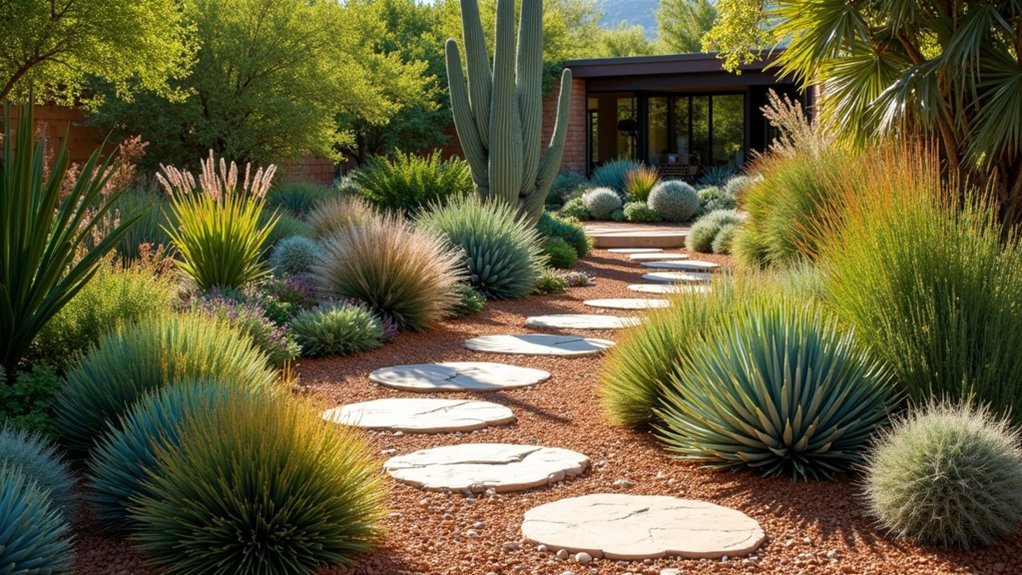
While planning your drought-resistant landscape, you’ll need clear organization to implement effective strategies.
Consider structuring your approach with these key headings:
“Selecting Drought-Tolerant Plants,” which guides you through choosing succulents, perennials, and native species that thrive with minimal water.
“Improving Watering Efficiency” can focus on grouping plants with similar moisture needs together for smarter irrigation practices.
“Incorporating Hardscaping Elements” should cover how gravel and permeable pavers reduce water runoff while enhancing your border’s appearance.
“Applying Organic Mulch” explains how a 3-4 inch layer conserves soil moisture and suppresses weeds.
Finally, “Reducing Water Usage with Stone Features” demonstrates how decorative rocks can define borders while eliminating additional water requirements.
These organized sections will help transform your thirsty landscape into a water-wise haven.
Selecting Native Boundary Plants for Water Conservation
When creating a water-wise landscape, native boundary plants offer the perfect combination of beauty and practicality. These drought-tolerant species require minimal irrigation while supporting local ecosystems. By choosing plants like Black-Eyed Susan and Purple Coneflower, you’ll attract pollinators while conserving water.
Group plants with similar moisture needs to maximize watering efficiency. Native plants’ deep root systems improve soil health and prevent erosion, making them ideal for sustainable borders.
| Plant Option | Water Needs | Benefits |
|---|---|---|
| Yarrow | Very Low | Thrives in poor soil |
| Lavender | Low | Fragrant, attracts bees |
| Purple Coneflower | Moderate | Wildlife habitat, drought recovery |
Even in challenging conditions, these native boundary plants will thrive with minimal care while creating visually stunning borders that require a fraction of the water conventional landscapes demand.
Creating Deep-Rooted Natural Barriers That Thrive in Dry Conditions

Beyond selecting native plants, establishing deep-rooted natural barriers represents a powerful strategy for drought-resistant landscapes. Choose drought-tolerant species like yarrow or purple coneflower that develop extensive root systems to access deeper soil moisture while preventing erosion.
Group plants with similar water needs closely together to maximize moisture retention and minimize water loss through evaporation. This dense planting approach creates natural barriers against both drought stress and unwanted weeds.
Apply organic mulch around your deep-rooted plants to insulate soil, reduce moisture evaporation, and suppress competing vegetation. Complement these plantings with strategic hardscaping elements like stone borders to manage runoff effectively.
During establishment, monitor soil moisture carefully, adjusting your watering schedule to encourage deep root development that will sustain your border through extended dry periods.
Designing Layered Border Plantings for Maximum Drought Resistance
Strategic layering of drought-tolerant plants creates borders that maintain visual interest while maximizing water efficiency in dry conditions.
Position taller species at the back, medium-height plants in the middle, and low-growing groundcovers in front to establish a visually appealing, three-dimensional landscape.
Group plants with similar water needs together to prevent moisture competition and optimize irrigation efficiency.
Native perennials and ornamental grasses appropriate for your climate zone will provide resilience while supporting local wildlife.
Incorporate drought-tolerant shrubs or small trees as structural focal points in the back layer, providing shade that reduces soil evaporation.
Finally, apply organic mulch throughout your layered border to retain moisture, suppress weeds, and regulate soil temperature.
This thorough approach guarantees your borders remain vibrant even during extended dry periods.
Strategic Mulching Techniques for Water-Efficient Boundaries
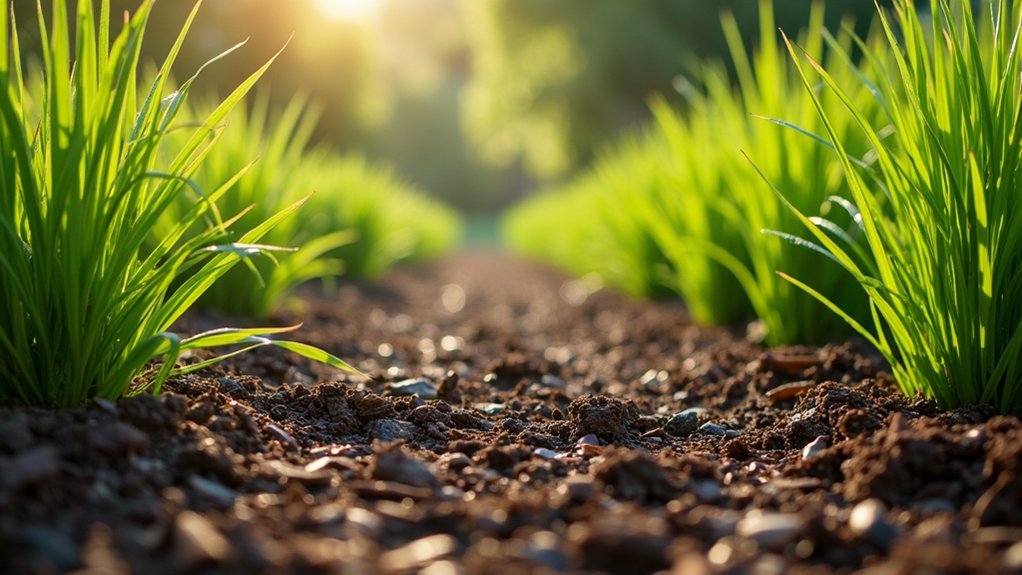
Proper mulching stands as one of the most effective techniques for creating water-efficient garden borders that thrive during drought conditions.
By applying a 2-4 inch layer of organic mulch around your drought-tolerant plantings, you’ll reduce evaporation by up to 30% while simultaneously suppressing water-stealing weeds.
Choose materials like shredded bark, wood chips, or straw that will break down over time, enriching your soil with organic matter and improving its structure.
This decomposition process enhances the soil’s ability to retain moisture even during extended dry periods.
Remember to keep mulch a few inches away from plant stems to prevent rot, and plan to replenish your mulch annually as it breaks down.
This simple maintenance routine guarantees your borders maintain ideal moisture levels with minimal watering throughout the seasons.
Xeriscaping Principles for Effective Border Management
When planning drought-proof borders, you’ll succeed by selecting native, drought-resistant plants and grouping them according to similar water requirements.
You can create visually striking yet practical zones by positioning high-water-need specimens near your home and shifting to more resilient varieties farther out.
The most impactful choice you’ll make involves applying a thick layer of organic mulch around your border plants, which dramatically reduces evaporation, suppresses weeds, and maintains consistent soil temperatures.
Plant Selection Strategies
Creating a drought-proof border begins with thoughtful plant selection strategies that embrace xeriscaping principles. Choose native drought-tolerant plants adapted to your region’s unique conditions—they’ll thrive with minimal water while offering maximum visual impact.
Group plants with similar water requirements together to establish efficient irrigation zones. This smart arrangement prevents overwatering some species while underwatering others. Incorporate varying heights and textures for aesthetic appeal while ensuring dense ground coverage to minimize soil evaporation.
Prioritize perennials over annuals in your borders, as they require less maintenance and water once established, providing year-round structure and seasonal interest.
Don’t overlook soil health—incorporate organic matter to improve moisture retention and create an environment where drought-resistant plants can flourish even during dry periods.
Zoning Water Needs
Effective border management hinges on strategic water zoning, a cornerstone of xeriscaping that considerably reduces water waste while maintaining visual appeal. By grouping plants with similar moisture requirements together, you’ll create efficient watering zones that minimize excess consumption.
Start by evaluating your landscape’s microclimates—areas with distinct sunlight exposure, soil composition, and moisture retention. This assessment allows you to designate specific zones where drought-tolerant natives can thrive with minimal intervention.
Implement tiered planting on sloped areas to capture runoff and maximize water absorption.
Don’t forget to apply a generous layer of mulch throughout your borders to suppress weeds, regulate soil temperature, and enhance moisture retention. This simple addition can considerably reduce maintenance while creating borders that remain vibrant despite water restrictions.
Mulch Matters Most
The single most impactful step you can take toward drought-proofing your borders is proper mulching. Apply at least 2 inches of mulch to greatly reduce moisture evaporation by up to 30% while simultaneously preventing weed competition for precious water resources.
Organic mulches deliver double benefits—they conserve moisture now and improve soil health as they decompose, requiring less watering in the long term. Remember to replenish your mulch regularly to maintain its effectiveness throughout the growing season.
| Mulch Type | Moisture Retention | Benefits |
|---|---|---|
| Wood Chips | Excellent | Long-lasting, decomposes slowly |
| Straw | Good | Inexpensive, lightweight |
| Compost | Very Good | Adds nutrients as it breaks down |
| Bark | Excellent | Attractive, resists wind displacement |
Establishing Root Systems That Withstand Extended Dry Periods
While beautiful blooms may catch the eye, it’s the invisible network beneath the soil that determines your drought-proof border’s success. Deep root systems allow plants to access moisture stored far below the surface during rainless weeks.
Select drought-tolerant plants that naturally develop extensive roots reaching several feet downward. When planting, provide ample spacing to encourage horizontal root expansion for maximum soil moisture absorption.
Choose plants with deep-seeking roots and give them room to stretch sideways, maximizing their drought-fighting potential.
To establish resilient gardens, water deeply but infrequently during the initial growth period. This training forces roots downward in search of hydration. The resulting robust root network will serve your garden well during future dry spells.
Remember to apply mulch around your plants—it not only conserves precious soil moisture but also creates cooler soil conditions that promote stronger root development during hot weather.
Companion Planting Strategies for Resilient Boundary Zones
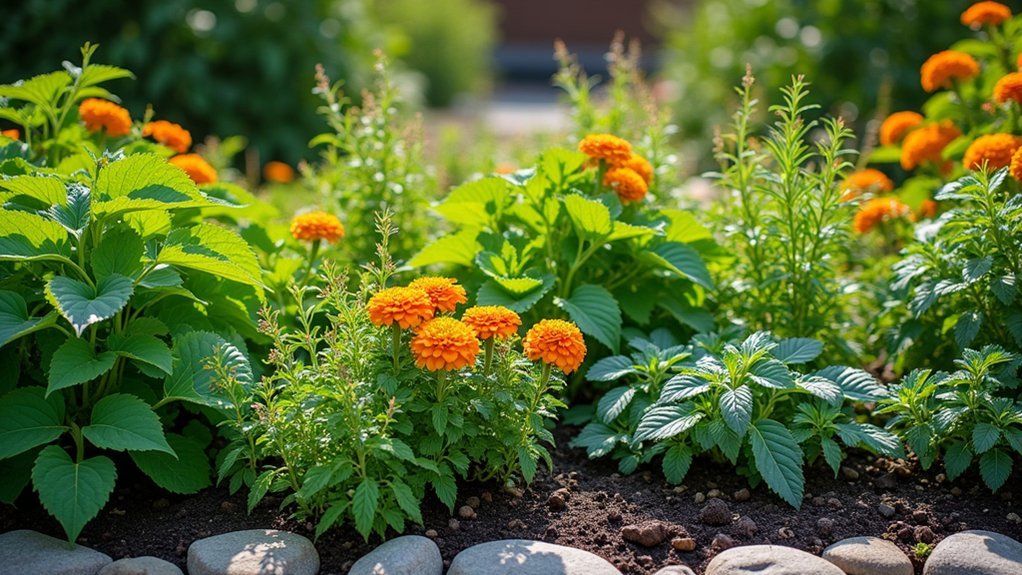
You’ll increase your garden’s drought resilience by strategically pairing plants with similar water needs, such as lavender with sage or black-eyed Susans with coneflowers.
Create layered water management by combining deep-rooted species like yarrow with shallow-rooted plants to improve soil structure and moisture retention throughout your border zones.
Don’t forget to enhance these plant groupings with mulch around your borders, which conserves soil moisture and suppresses water-stealing weeds.
Strategic Plant Groupings
Strategic groupings of drought-tolerant plants form the backbone of resilient boundary zones in water-conscious landscaping. By clustering plants with similar water needs, you’ll enhance irrigation efficiency while reducing competition for moisture. Incorporate native plants into these strategic groupings to promote local biodiversity and attract essential pollinators.
| Grouping Type | Benefits | Best Practices |
|---|---|---|
| Height Zoning | Creates visual interest | Tall plants as backdrop, medium in middle, low in front |
| Water Needs | Optimizes irrigation | Group high, medium, and low water users separately |
| Function | Enhances resilience | Combine shade-creators with drought-tolerant ground covers |
Dense plantings along your borders help reduce evaporation by shading the soil. This natural canopy maintains moisture levels during dry periods, creating microclimates that benefit all your drought-tolerant selections while minimizing maintenance requirements.
Layered Water Management
Creating resilient boundary zones requires thoughtful companion planting strategies that maximize limited water resources. By grouping drought-tolerant plants with similar needs, you’ll create efficient microclimates that enhance overall resilience while reducing competition for precious moisture.
Implement these companion planting techniques for water-wise boundaries:
- Pair deep-rooted drought-resistant plants with shallow-rooted species to access water from different soil depths.
- Create protective microclimates by positioning taller plants to shade more delicate companions.
- Apply mulch around plant groupings to retain soil moisture and regulate temperature fluctuations.
- Establish dense patches of native species that naturally support each other’s water needs.
You’ll find that strategic companion planting not only improves water utilization but also creates healthier plant communities that withstand drought conditions with minimal intervention, making your boundary zones both beautiful and sustainable.
Frequently Asked Questions
How to Design a Drought-Tolerant Front Yard?
Design your drought-tolerant front yard by evaluating sun exposure and soil, incorporating native plants and succulents, replacing lawns with hardscaping, applying mulch to retain moisture, and installing efficient irrigation systems.
What Is the Most Drought-Tolerant Ground Cover?
Creeping thyme (Thymus serpyllum) is your most drought-tolerant ground cover option. It’s incredibly resilient in full sun with minimal water once established. Sedums like ‘Dragon’s Blood’ are excellent alternatives you’ll appreciate for dry landscapes.
What Is the Best Drought-Resistant Crop?
Sorghum is your best drought-resistant crop choice. It thrives in arid conditions with minimal water needs. You’ll also find quinoa, cowpeas, amaranth, and millet excellent options for drought-prone areas with poor soil.
What Is the Most Drought-Resistant Plant?
Succulents like Aloe Vera and Sedum are your most drought-resistant plants. They’ll store water in their leaves, surviving extended dry periods. Black-Eyed Susan and Sunny Boulevard® St. Johns Wort also excel in arid conditions.
In Summary
You’ve got all the tools to create stunning drought-resistant borders that’ll thrive with minimal water. By combining native plants, strategic mulching, and smart design principles, you’re not just creating boundaries—you’re building resilient ecosystems. Remember to focus on establishing strong root systems and companion planting. With these techniques, you’ll enjoy beautiful, sustainable borders that stand up to dry conditions while conserving precious water resources.

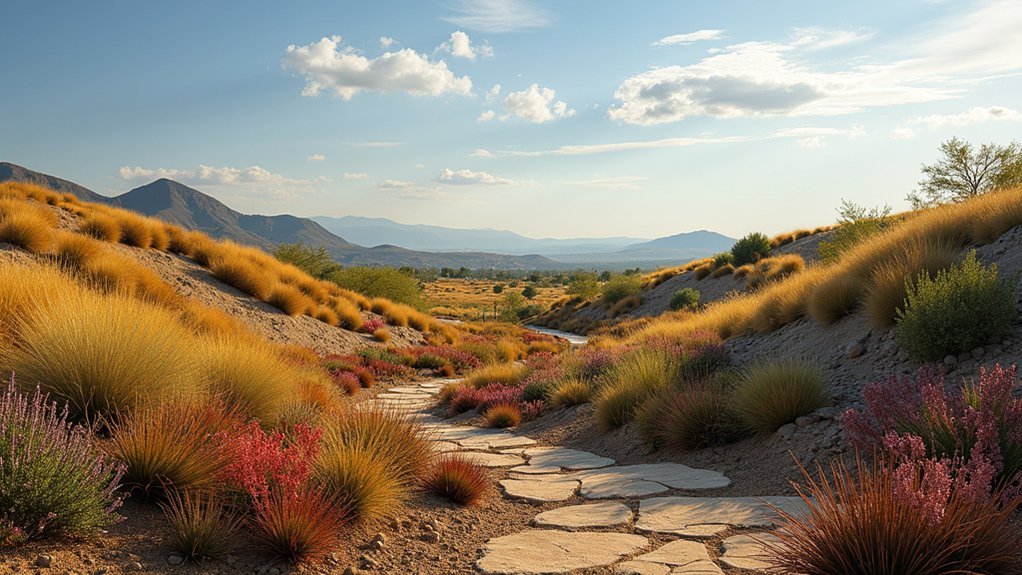

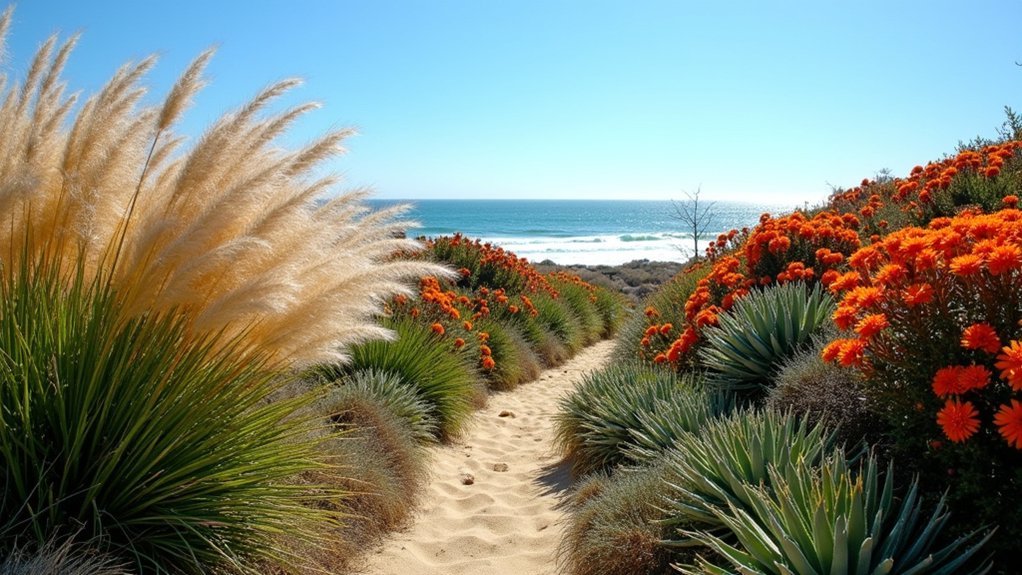
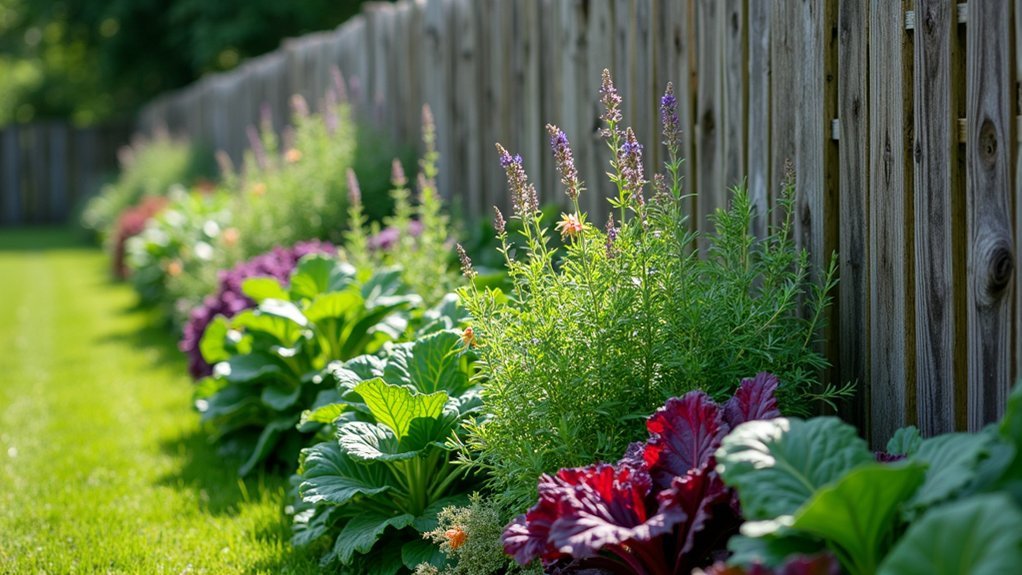
Leave a Reply